Diversification of tourist product vs. changes in the spatial systems of tourist development of Malta
DOI:
https://doi.org/10.24917/20801653.293.6Keywords:
educational tourism, Malta, small islands, sports tourismAbstract
At present, tourism has become the leading sector in many geographical locations. It offersthe opportunity to activate the local labour force, increase income of the local population and intensifyindustrial development. In case of tourist regions which specialise in recreation tourism, an importantquestion emerges about the future development trends ensuring sustainability of the local tourist development.A well-proven method to maintain or increase the importance of tourism is to diversify theproduct based on new types of tourist traffic. Such activities result in changes in the tourist developmentstructures and types, which create opportunities of acquiring new clients. Malta offers attractive conditionsfor developing recreation tourism (picturesque beaches, clean and warm sea), cultural tourism(megalithic temple complexes, historical cities) and linguistic tourism (language courses). When comparedto 1980s, a 50% growth in the tourist traffic has been reported, also in consequence of a diversifiedtourist product through introduction of qualified tourism (diving, climbing, caving, golf).Downloads
Metrics
References
Beeley, B., Charlton, W. (1994). Maltese Patterns of Dependence: An Historical Perspective. Scottish Geographical Magazine, 110, 112–120.
Boissevain, J. (1979). The impact of tourism on a dependent Island: Gozo, Malta. Annals of Tourism Research, 6, 76–90.
Boissevain, J., Theuma, N. (1998). Contested Space. Planners, Tourists, Developers and Environmentalists in Malta. W: S. Abram, J. Waldren (red.). Anthropological Perspectives on Local Development. Londyn: Routledge, 96–119.
Bramwell, B. (2003). Maltese Response to Tourism. Annals of Tourism Research, 30(3), 581–605.
Bull, C., Weed, M. (1999). Niche markets and small island tourism: the development of sports tourism in Malta. Managing Leisure. 4(3), 142–155. DOI: 10.1080/136067199375814
Chapman, A., Speake, J. (2011). Regeneration in a mass-tourism resort: The changing fortunes of Bugibba, Malta. Tourism Management, 32, 482–491.
Cunningham, A.G. (2008; 2015, 21 stycznia). The resort that Bugibba should be. Available from. Times of Malta. Pozyskano z http://www.timesofmalta.com/articles/view/20081204/letters/the-resortthat- bugibba-should-be.235679
Dodds, R. (2007). Malta’sTourism Policy: Standing Still or Advancing towards Sustainability? Island Studies Journal, 2(1), 47–66.
Hotia, S., McAleera, M., Shareef, R. (2007). Modelling international tourism and country risk spillovers for Cyprus and Malta. Tourism Management, 28, 1472–1484.
King, R. (1979). Developments in the Political and Economic Geography of Malta. Tijdschrift voor Economische En Sociale Geografie, 70, 258–271.
Kotler, P.H. (1994). Marketing od A do Z. Warszawa: Polskie Wydawnictwo Ekonomiczne.
Lockhart, D. (1997). Tourism to Malta and Cyprus. W: D. Lockhart, D. Drakakis-Smith (red.). Island Tourism: Trends and Prospects. Londyn: Pinter, 152–178.
Lockhart, D., Mason, K. (1989). A Social and Economic Atlas of Malta and Gozo. Occasional Paper, 16.
Malta Environment and Planning Authority (2001). Tourism Topic Paper. Pozyskano z https://www.mepa.org.mt/lpg-structureplanreview#Tourism
Mika, M. (2014). Założenia i determinanty podtrzymywalności lokalnego rozwoju turystyki. Kraków: Instytut Geografii i Gospodarki Przestrzennej Uniwersytetu Jagiellońskiego.
Oglethorpe, M. (1985). Tourism in a small island economy: the case of Malta. Tourism Management, 6, 23–31.
Planning Authority (2000). Structure plan for the maltese islands tourism. Topic study. Final Draft. Pozyskano z http://www.mepa.org.mt/lpg-structureplan.html
Szwajca, D. (2009). Pozycjonowanie marki na rynku globalnym – możliwości i ograniczenia. Economy and Management, 1, 44–59.
Thake, C., Hall, B. (1993). Valletta. Cities. 10, 91–102.
Theuma, N. (2006). Malta: Re-imaging the Mediterranean Destination. W: H. Derek, M. Smith, B. Marciszewska (red.). Tourism in the New Europe: The Challenges and Opportunities of EU Enlargement, 213–224.
Tourism in Malta (2014). Malta Tourism Authority. Pozyskano z http://www.mta.com.mt Tourism industry sub-sectors (2014; 2015, 22 stycznia).
Country Report Malta. Pozyskano z http:// ec.europa.eu/growth/tools-databases/tourism-business-portal/documents/business/internationalisation/ malta-country-report.pdf
Downloads
Published
How to Cite
Issue
Section
License
Articles are published under the terms of the Creative Commons License (CC BY-ND 4.0; Attribution– NoDerivs).

